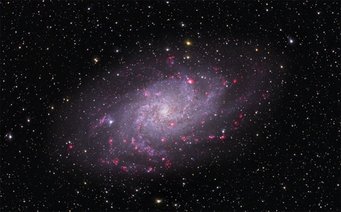Magnetic fields set the stage for the birth of new stars
Astronomers at the Max Planck Institute for Astronomy have, for the first time, measured the alignment of magnetic fields in gigantic clouds of gas and dust in a distant galaxy. Their results suggest that such magnetic fields play a key role in channeling matter to form denser clouds, and thus in setting the stage for the birth of new stars. The work will be published in the November 24 edition of the journal Nature (online version: November 16).
| Background information | Questions & Answers | Image download |

Stars and their planets are born when giant clouds of interstellar gas and dust collapse. You've probably seen the resulting stellar nurseries in beautiful astronomical images: Colorful nebulae, lit by the bright young stars they have brought forth.
Astronomers know quite a bit about these so-called molecular clouds: They consist mainly of hydrogen molecules – unusual in a cosmos where conditions are rarely right for hydrogen atoms to bond together into molecules. And if one traces the distribution of clouds in a spiral galaxy like our own Milky Way galaxy, one finds that they are lined up along the spiral arms.
But how do those clouds come into being? What makes matter congregate in regions a hundred or even a thousand times more dense than the surrounding interstellar gas?
One candidate mechanism involves the galaxy's magnetic fields. Everyone who has seen a magnet act on iron filings in the classic classroom experiment knows that magnetic fields can be used to impose order. Some researchers have argued that something similar goes on in the case of molecular clouds: that galaxies' magnetic fields guide and direct the condensation of interstellar matter to form denser clouds and facilitate their further collapse.
Some astronomer see this as the key mechanism enabling star formation. Others contend that the cloud matter's gravitational attraction and turbulent motion of gas within the cloud are so strong as to cancel any influence of an outside magnetic field.
If we were to restrict attention to our own galaxy, it would be difficult to find out who is right. We would need to see our galaxy's disk from above to make the appropriate measurements; in reality, our Solar System sits within the galactic disk. That is why Hua-bai Li and Thomas Henning from the Max Planck Institute for Astronomy chose a different target: the Triangulum galaxy, 3 million light-years from Earth and also known as M 33, which is oriented in just the right way (cf. image).
Using a telescope known as the Submillimeter Array (SMA), which is located at Mauna Kea Observatory on Mauna Kea Island, Hawai'i, Li and Henning measured specific properties of radiation received from different regions of the galaxy which are correlated with the orientation of these region's magnetic fields. They found that the magnetic fields associated with the galaxy's six most massive giant molecular clouds were orderly, and well aligned with the galaxy's spiral arms.
If turbulence played a more important role in these clouds than the ordering influence of the galaxy's magnetic field, the magnetic field associated with the cloud would be random and disordered.
Thus, Li and Henning's observations are a strong indication that magnetic fields indeed play an important role when it comes to the formation of dense molecular clouds – and to setting the stage for the birth of stars and planetary systems like our own.
Background information
The work described here will be published in the November 24, 2011 edition of Nature as H. Li and T. Henning, "The alignment of molecular cloud magnetic fields with the spiral arms in M33". The article will be published online on November 16.
The research is supported by the Max Planck Institute for Astronomy and the Harvard-Smithsonian Center for Astrophysics. The Submillimeter Array is a joint project between the Smithsonian Astrophysical Observatory and the Academia Sinica Institute of Astronomy and Astrophysics and is funded by the Smithsonian Institution and the Academia Sinica.
Link to article: http://dx.doi.org/10.1038/nature10551
Questions and Answers
Which telescopes were used in this research?
The observations were made with the Submillimeter Array (SMA), which is located at Mauna Kea Observatory on Mauna Kea island, Hawai'i. The SMA consists of 8 submillimeter telescopes, each with a radio dish 6 metres in diameter. The antenna can be operated jointly; when it comes to discerning details in the sky, the joint antenna array can achieve similar results to a single radio telescope up to 509 metres in diameter. The SMA is a joint project between the Smithsonian Astrophysical Observatory and the Academia Sinica Institute of Astronomy and Astrophysics and is funded by the Smithsonian Institution and the Academia Sinica.
What did the radiation tell the researchers about the magnetic fields?
Specifically, Li and Henning measured the polarization of radiation that is produced by carbon monoxide (CO) molecules that are present in trace amount in these molecular clouds. Polarization is a property that represents characteristic alignments of a light wave's electric and magnetic fields. The polarization carries information about the orientation of the magnetic fields in the regions where the radiation was produced. It is not possible to reconstruct all details of the magnetic fields in this way – some different configurations can lead to the same polarization pattern – but it is possible to draw conclusions about whether the magnetic field is oriented randomly, or very likely oriented along the spiral arms.
How do magnetic fields facilitate the formation and collapse of molecular clouds?
There is a small percentage of ions in the molecular clouds, forming a plasma. This plasma is "anchored" to the magnetic field lines, and can only move along field lines, and it makes the (much more numerous) molecules in the cloud move in a similar way. A similar effect can be observed in another astronomical situation: Electrically charged particles emitted by the Sun ("solar wind") that reach Earth are constrained to move along our home planet's magnetic field lines. In this way, the particles are led towards the Earth's poles, where they are responsible for Northern lights and their Southern counterparts.
The constricting influence of the magnetic fields is important because it is not at all simple for a molecular cloud to collapse to the density required to form stars and planets. Most particles will move not only towards the center of the collapse, but also sideways (in physics-speak, this is the conservation of angular momentum). The presence of magnetic field lines that are aligned on a large scale will impose a certain order, reducing some of the sideways motion and facilitating the collapse.
What further directions for research do these results suggest?
Similar studies on other, more distant face-on galaxies are a logical next step. Also, simulations and theoretical work should allow astronomers to predict characteristic properties of groups of stars forming within a region with an ordered magnetic fields. Further observations should allow for testing these predictions. For more distant galaxies, suitably detailed measurements will only be possible with the next generation of submillimetre telescopes, notably with ALMA, the Atacama Large Millimetre/submillimetre Array currently under construction in Chile by the European Southern Observatory and its collaborators in East Asia, North America, and Chile.

Download area



